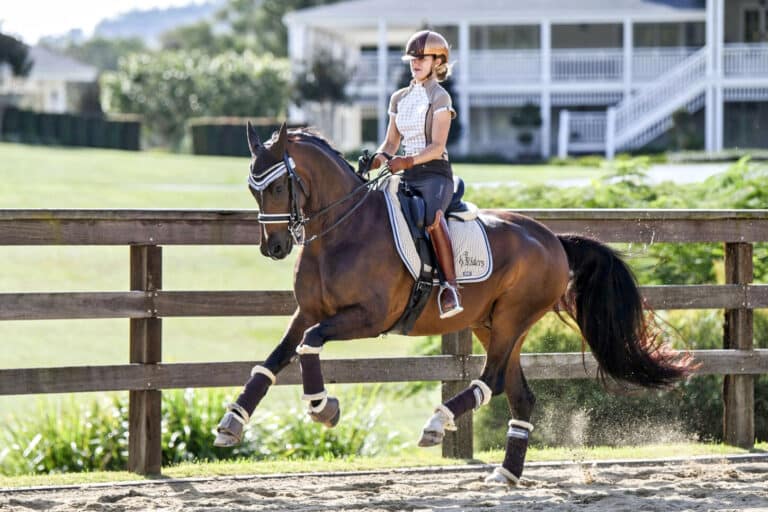What exactly do we mean when we say forward? National A Level dressage judge and trainer NICOLE TOUGH explains.
One of the greatest misunderstandings in dressage training surrounds the concept of forward. Quotes from the world’s best trainers, like ‘first and foremost the horse must go forward’, can be misinterpreted to mean ‘first and foremost the horse needs to go fast’. This seems especially so in eventing dressage.
The word forward means a ‘direction to which one is facing or moving’, or ‘moving onward to make progress’. In dressage terms, the desire to move forward is a most important concept, and allotted a collective mark in every dressage test within Impulsion.
Forward has nothing to do with the speed at which we are travelling, and everything to do with attitude. If the horse has the desire to move forward, they are more likely to be on the aids; and if they are lacking in the desire to move forward, they will likely be behind the aids. In dressage terms, there are generally two types of horses, the energy savers and the overachievers.
By nature, energy savers are always looking to expend as little energy as possible. They will inevitably test their rider every training session by not answering questions with immediacy, but rather in their own time a few steps later. They will slow down, or come behind the leg, at any and all opportunities. These horses generally trick their riders into sweating more than they do through the need to constantly nag through leg aids that say, come on, stay in walk, keep marching, keep trotting, stay in canter – please. These horses dawdle and would be late to class all the time.
The challenge for the rider of an energy saver is to take the leg off. Dare the horse to make the mistake of slowing down of their own accord, and when they do – gallop! Surprise! And then, to be consistent, every time the horse slows down of their own accord, the rider should correct this mistake with a quick acceleration (i.e. gallop for 10 to 15 metres) the moment they feel the horse back off, stall or hesitate.
Surprise can work well with these horses.

This technique works for energy savers and can change their backward thinking tendency to be more forward thinking. As a trainer, it is imperative that we feel our horse asking ‘can I go now’… but this does not mean riding fast.
And please note: the rider of an energy saver can get drawn into the pattern of riding their horse in this up tempo (i.e: fast) all the time. The surprise acceleration is just a
correction, and it may need repeating many times every session before the concept of thinking ‘can I go now’, is actually programmed into them. And yes, it will feel like Groundhog Day every day, because they are energy savers by nature.
Overachievers, on the other hand, need a different approach. These horses tend to be on higher alert; they over think, and/or tend to run away when life gets difficult.
Never surprise an overachiever!
It is imperative that overachievers learn to wait. Wanting to go forward is wonderful; but it must never be an evasion. These horses think ahead and worry about what they suspect is going to be asked of them before it even happens, often causing the gait they are in to lose quality. A ‘go-ey’ type of horse can trick their rider into having no leg on, which results in too much weight in the hand – thus riding with a permanent hand brake on.
Useful techniques for riders of overachievers include tiny walk steps until the horse accepts the leg and the balance, one step at a time, and the rider feels like they’re driving the car and not just steering it. This is focusing on balance before adding impulsion. Also good for our spicier horses are any exercises that require the leg on. Lots of lateral work aiming at acceptance of leg contact, and ultimately developing an effective half-halt, thus achieving self-carriage.
Overachievers are reactive and we need reaction, but we need their natural flight instinct on our side. There is no use for energy if we can’t control it.
Once we have the horse thinking forward and/or learning to wait, then we get to develop impulsion and start adding the gears.
And here’s an observation learned from 30 years coaching and training: most riders have the type of horse that suits their personality and riding style. This doesn’t make the rider a bad rider, or the horse a bad horse, but if a nervous rider has an overachiever, it does increase the challenge.
Remember – the more you ride, the better you get.
Happy training.
Visit Nicole Tough Dressage Team for information on lessons, clinics, and horses for sale.
Main Image: Forward has nothing to do with the speed at which we are travelling, and everything to do with attitude (Image by Christy Baker).



